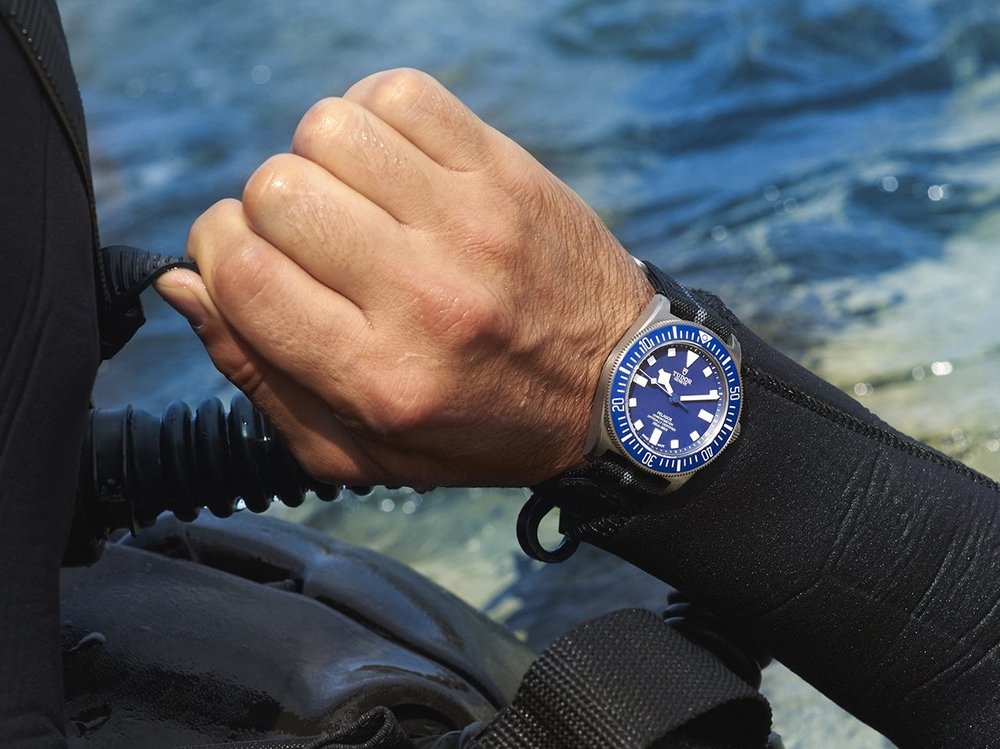
How to Maintain Your Dive Watch for Optimal Performance
, by Benjamin Davis, 8 min reading time

, by Benjamin Davis, 8 min reading time
A dive watch is the epitome of a "tool" watch — robust, purpose-built, and practical. And no, it doesn't need to be anywhere near a coral reef to count! However, even though these timepieces are designed to be robust, they are not invincible. Even those who love dry land more than the open sea should pay attention to the specific characteristics and potential vulnerabilities of these rugged watches. Here's a guide for ensuring your treasured timepiece stays as pristine as the deep sea it was crafted to explore, whether you're about to go diving or splash out on purchasing one.

Screw Down the Crown
One of the simplest yet most critical aspects of maintaining your dive watch is to ensure that the crown is firmly screwed down. This action does not merely serve an aesthetic purpose. It essentially forms the first line of defence against water intrusion and thus, safeguards the delicate internal mechanism of the watch.
Know Your Limits
Just as a diver must comprehend the constraints of their own physical endurance, it's equally vital to understand the limits of your dive watch's water resistance. Manufacturers designate a specific depth rating for each dive watch, which quantifies how water resistant it is. Remember, these are tested under perfect lab conditions and reality can often be harsher. Consequently, it’s of paramount importance not to push your timepiece beyond its stated resistance. Avoid showers, saunas, and hot tubs with your dive watch, as they subject your timepiece to a different kind of pressure that may not be conducive to its longevity. It's not all doom and gloom though; by respecting the watch's specifications, you ensure your trustworthy underwater companion stays in peak condition!
Depths are Tolerable, Heat and Grease are Not
Sunscreen, although essential for protecting our skin, can pose a threat to your watch gaskets. Intense temperature changes, like those encountered in a sauna or steam room, can make them contract or expand. When these shifts occur, water can seep into your timepiece, creating the exact situation it was built to avert.
Rinsing
Whilst dive watches are made to resist corrosion, it still pays to give them a gentle rinse in freshwater after any sea adventures. As you do, rotate the bezel to ensure you thoroughly flush out any traces of saltwater or sunscreen, which have the potential to deteriorate the seals. Do refrain from using soap or other chemicals; pure H2O will do the trick. Remember to thoroughly dry your watch post-rinse.
Service it, Protect it, Cherish it
Pencil into your diary a reminder to have your watch professionally pressure-tested every three to five years. Also, consider having the all-important gaskets replaced if necessary - these little rubber heroes are the last line of defence against an expensive repair job. If you've inherited a vintage diver and its only exposure to high pressure is a Kendrick Lamar track at your local pub's trivia night, it's still worth getting it serviced; the oils that lubricate the movement could have dried up over time.
Your diver's watch is your loyal friend in deep waters. But remember, like any friend, it needs a bit of tender, loving care. Among the components of your watch, the strap demands a special mention. Whether it's rubber, metal, nylon, or leather, it can show signs of ageing sooner than you would like, if not cared for well.
While rubber and silicone straps are built for endurance, don't take them for granted. Take these steps to add years to their lifespan:
Metal straps, like those made of stainless steel or titanium, can be quite resilient. But certain things can tarnish their style:
Although nylon is durable, leather especially needs gentle treatment:
If a dive watch is not properly maintained, there are several potential risks and damages that can occur. One of the most common issues is water damage. Dive watches are designed to be water-resistant, but over time, the seals and gaskets can deteriorate, leading to water leakage. This can result in condensation inside the watch, which can damage the internal components and affect its accuracy and functionality. In severe cases, water ingress can cause irreversible damage to the movement, requiring expensive repairs or even complete replacement of the watch.
Another risk of improper maintenance is the buildup of dirt, dust, and debris. When a dive watch is exposed to the elements, such as sand, saltwater, or even everyday dirt, these particles can find their way into the watch case and affect its performance. The accumulation of dirt can hinder the smooth movement of the watch hands and compromise the accuracy of timekeeping. Additionally, dirt particles can scratch the watch crystal or damage the bezel, affecting the overall appearance and functionality of the watch.
Lack of regular maintenance can also lead to mechanical issues. Dive watches are intricate timepieces with delicate mechanical movements. Without proper care, the lubricants inside the watch can dry out or degrade, causing increased friction and wear on the components. This can result in reduced accuracy, loss of power reserve, or even complete failure of the movement. Additionally, if the watch is not regularly serviced, small issues that could have been easily fixed may escalate into more significant problems, requiring more extensive repairs and higher costs.
Lastly, neglecting to maintain a dive watch can affect its overall lifespan. Regular maintenance, such as cleaning, lubrication, and servicing, helps to keep the watch in optimal condition and extend its longevity. By neglecting these essential tasks, the watch may experience premature wear and tear, leading to a shorter lifespan. Proper maintenance not only ensures the watch's optimal performance but also protects your investment, allowing you to enjoy your dive watch for years to come.
When it comes to storing a dive watch when not in use, there are a few best practices to follow. Firstly, it is important to keep your dive watch in a cool and dry place. Exposure to extreme temperatures or high humidity can damage the internal components of the watch. Therefore, avoid storing it in areas such as a hot car or a damp bathroom. Instead, opt for a drawer or a watch box in a room with controlled temperature and humidity levels.
Secondly, it is recommended to store your dive watch away from direct sunlight. Prolonged exposure to sunlight can cause the watch's dial and strap to fade or deteriorate over time. Therefore, choose a storage location that is away from windows or any other sources of direct sunlight.
Furthermore, it is advisable to store your dive watch in a dedicated watch case or box. This will provide additional protection from dust, scratches, and potential impacts. Look for a case that has compartments or individual slots to keep each watch separate, preventing them from rubbing against each other.

Additionally, it is crucial to ensure that your dive watch is fully dry before storing it. After any water exposure, whether it be from diving or simply washing your hands, make sure to dry the watch thoroughly with a soft cloth. Moisture trapped inside the watch can lead to corrosion and damage the internal mechanisms. Take extra care to dry the areas around the crown and pushers, as these are vulnerable points for water ingress.
Lastly, if you have a mechanical dive watch, consider winding it before storing it for an extended period. This will help keep the movement lubricated and prevent any parts from seizing up. However, if you have an automatic dive watch, it is best to store it in a watch winder to keep the movement running smoothly.


